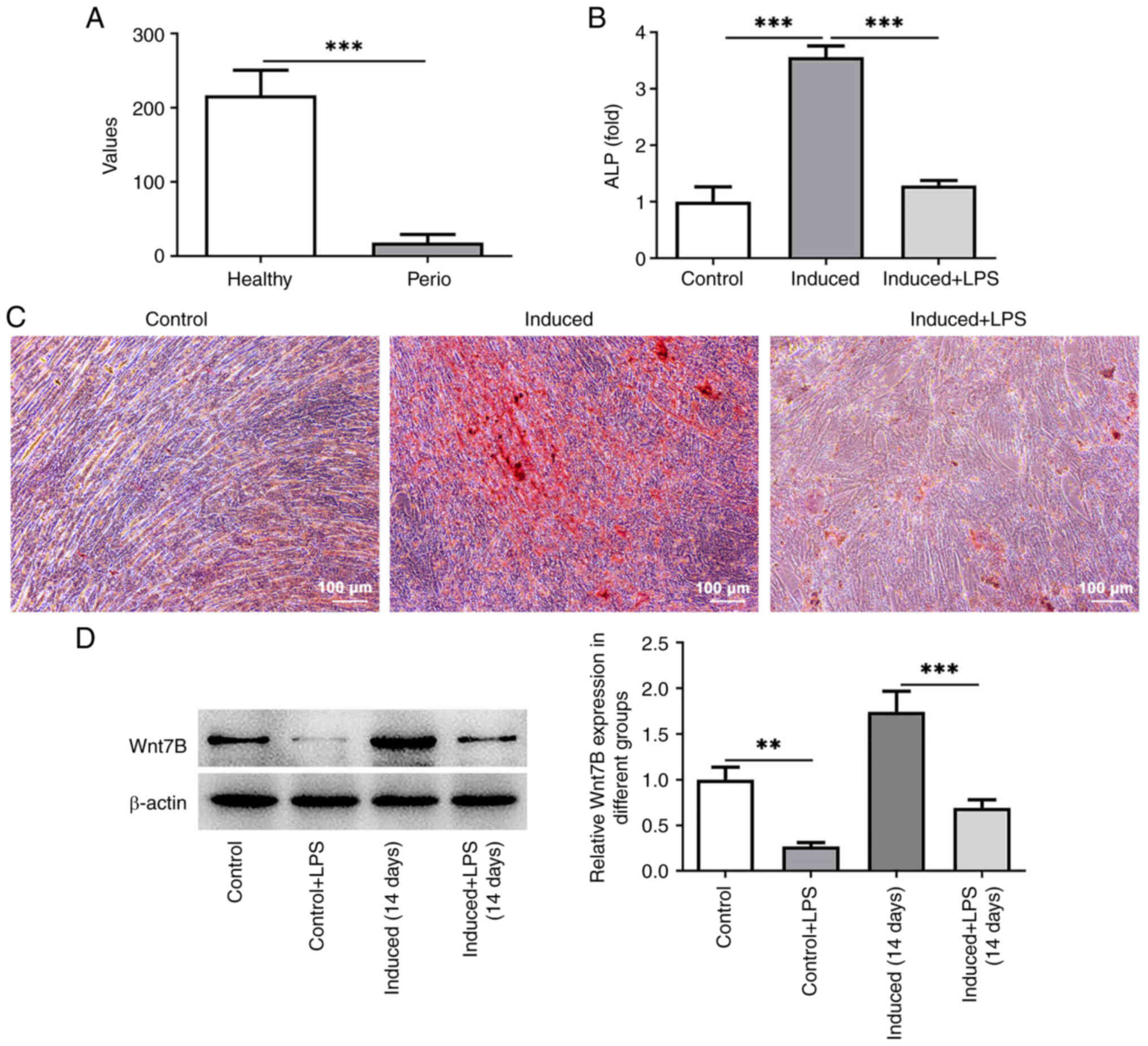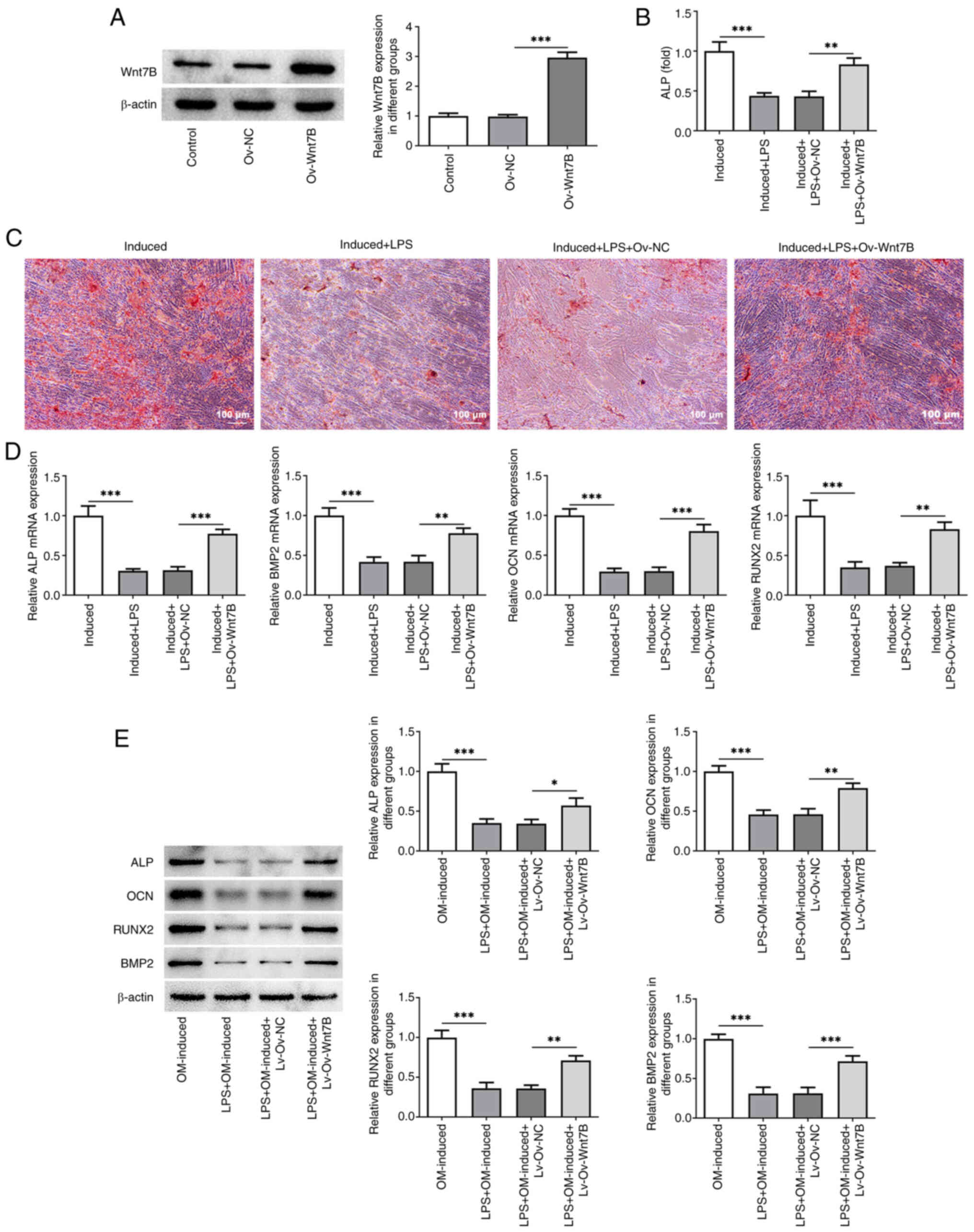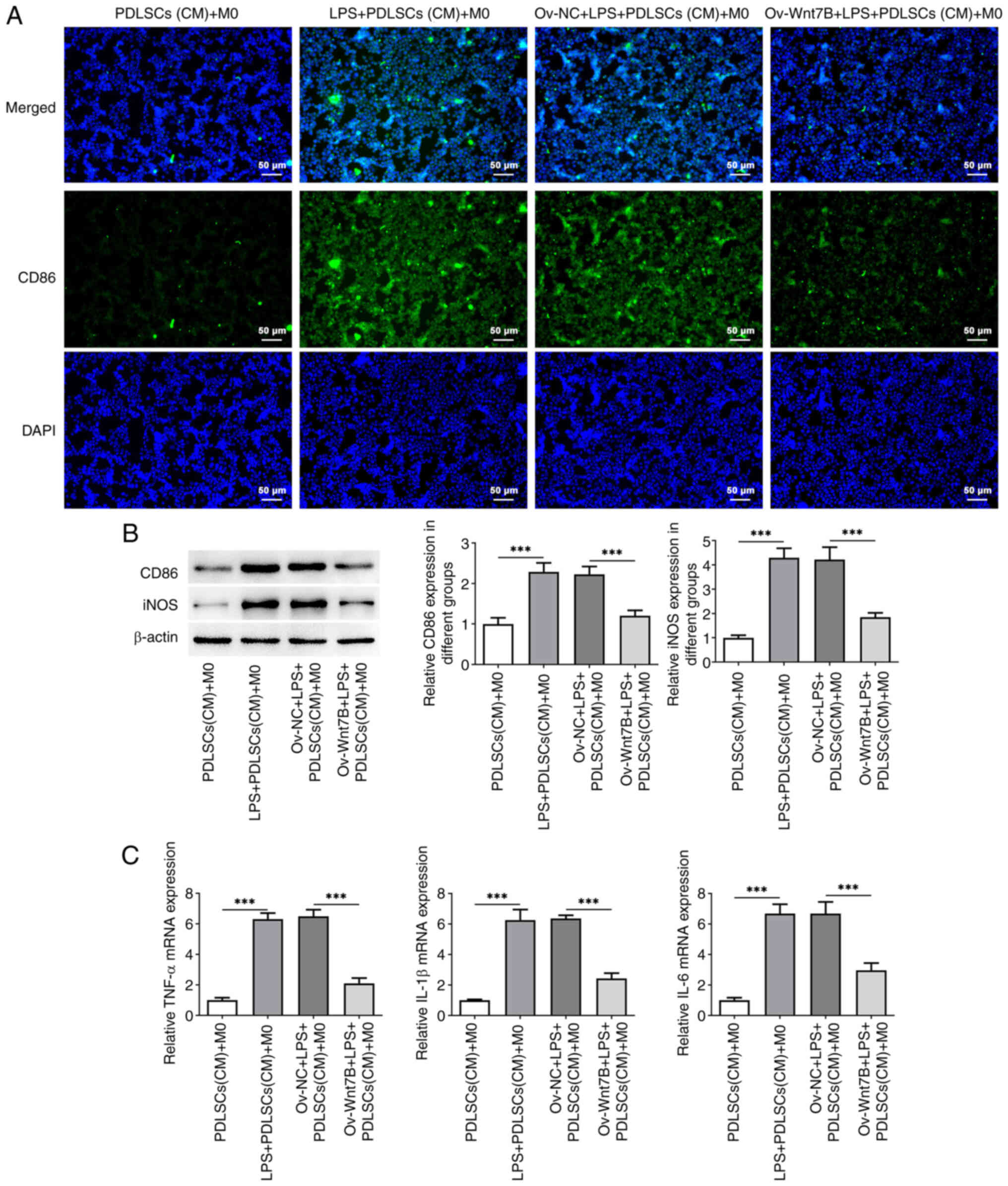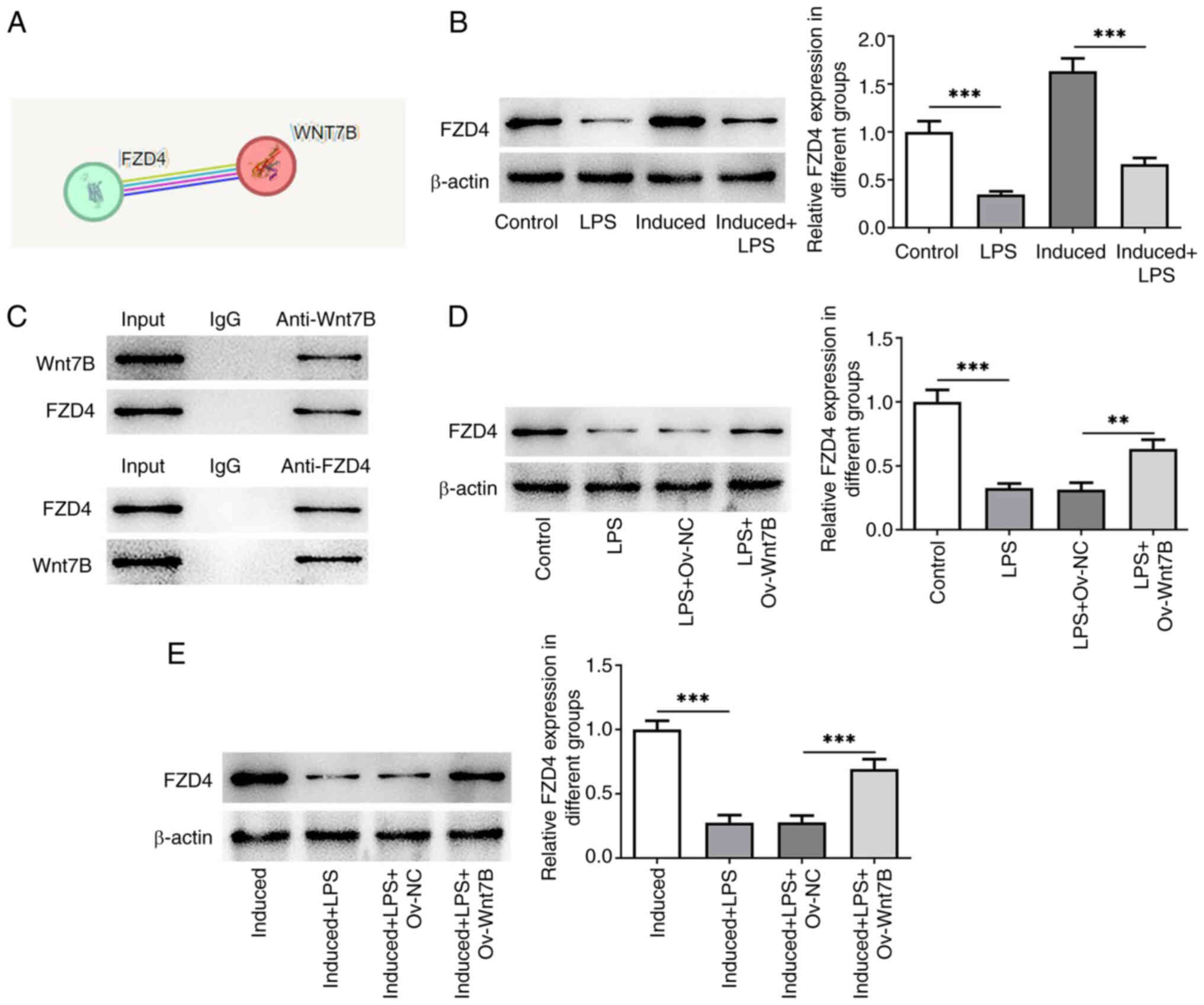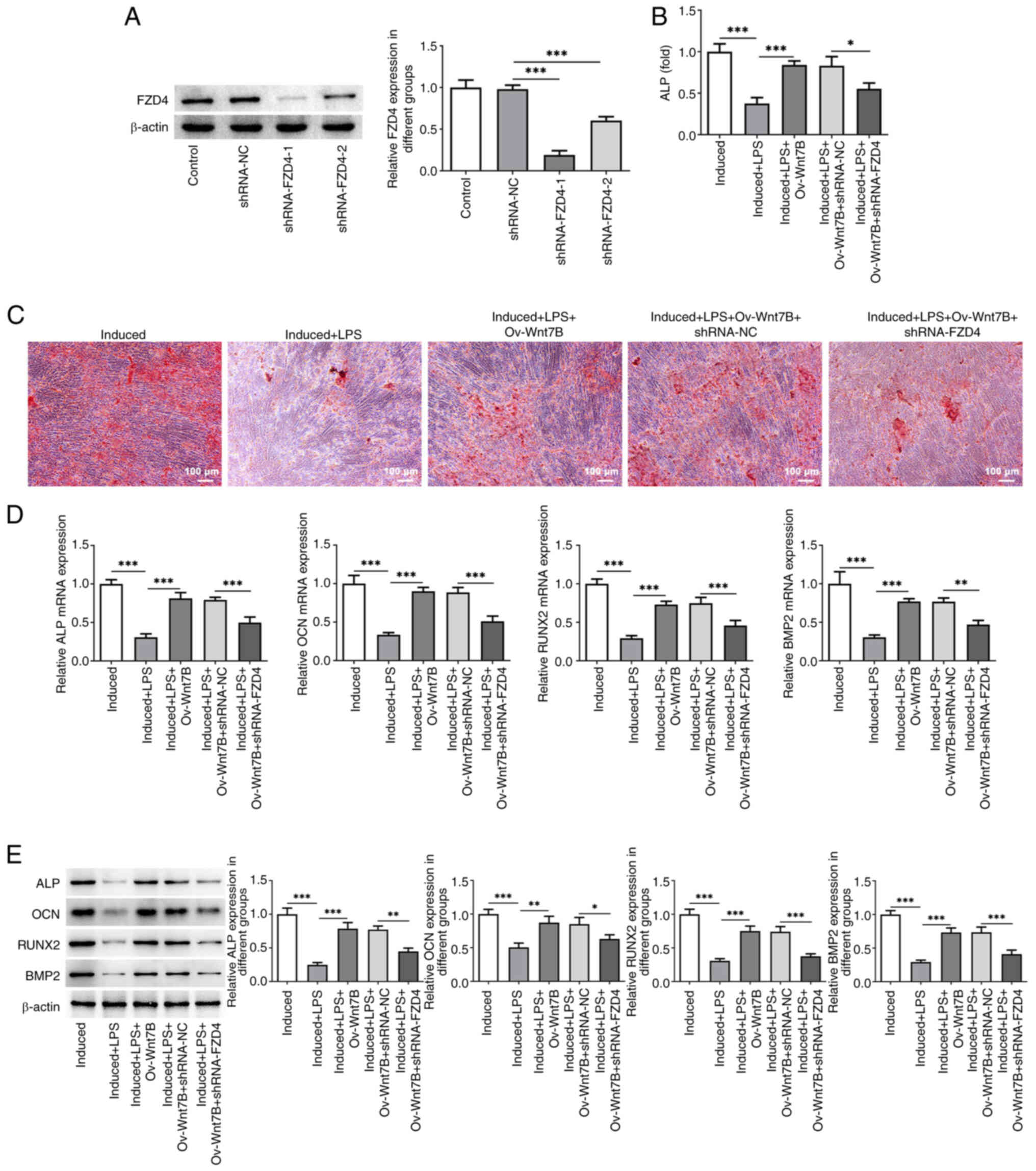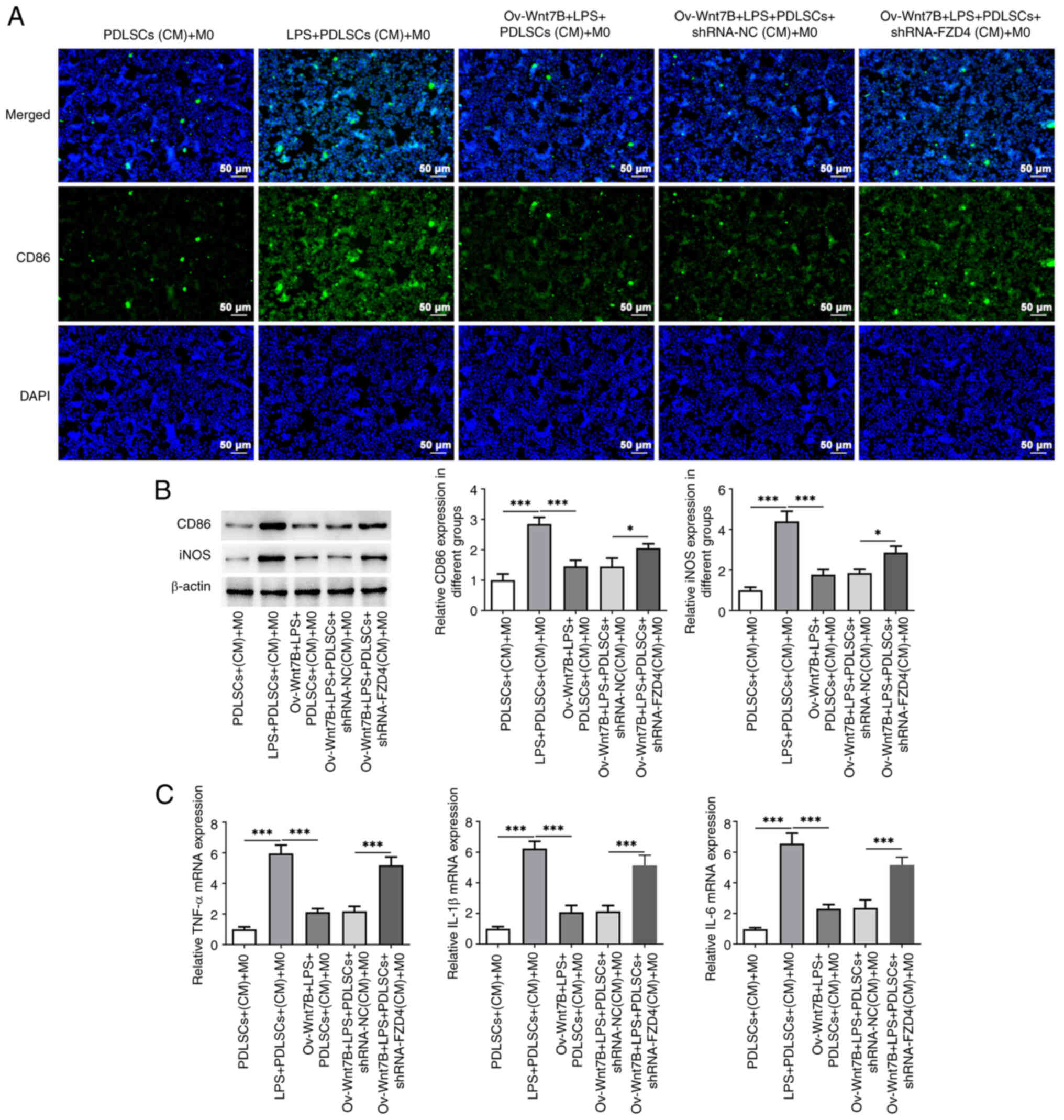Wnt7B enhances the osteogenic differentiation of lipopolysaccharide-stimulated human periodontal ligament stem cells and inhibits the M1 polarization of macrophages by binding FZD4
- Authors:
- Published online on: September 10, 2024 https://doi.org/10.3892/mmr.2024.13327
- Article Number: 203
-
Copyright: © Yang et al. This is an open access article distributed under the terms of Creative Commons Attribution License.
Abstract
Introduction
Periodontitis is a chronic inflammatory disorder of the periodontium characterized by bacterial infection, as well as the loss of attached gum and alveolar bone, which is manifested by destruction of periodontal tissues (1). Periodontal nursing intervention and standard self-plaque control can effectively reduce the number of periodontal pathogenic microorganisms in the dental plaque, which is crucial for reducing disease progression and recurrence (2). Human periodontal ligament stem cells (PDLSCs) derived from periodontal tissue are one of the main functional cells for periodontal tissue regeneration and repair (3,4). As ideal seed cells for periodontal tissue engineering, PDLSCs have a high proliferative capacity and multi-directional differentiation potential, which allows them to differentiate into osteoblasts to repair the damaged alveolar bone and periodontal ligament in periodontitis (5,6). There is a growing body of evidence to suggest that the periodontal inflammatory microenvironment caused by the increased oral bacterial burden can affect the bone regenerative ability of PDLSCs (7,8). Thus, inhibiting the inflammatory damage and enhancing the osteogenic differentiation ability of PDLSCs may prove to be a promising approach for the treatment of periodontitis.
Macrophages exert significant effects on the immune response during the occurrence, development and resolution of periodontitis. Due to the plasticity and diversity of macrophages, naive macrophages (M0) can differentiate into type M1 and type M2 macrophages (9). M1 macrophages can regulate osteoclast activation and secrete a large number of pro-inflammatory cytokines involved in the progression of periodontitis, including TNF-α) IL-1β and IL-6 (10). By contrast, M2 macrophages restrain pro-inflammatory cytokine production and facilitate tissue repair and regeneration (11). Vesicles from lipopolysaccharide (LPS)-stimulated PDLSCs promote the conversion of macrophages to the M1 type and facilitate the release of inflammatory factors (12). It has also been reported that LPS-stimulated PDLSCs can induce the M1 polarization of macrophages (13). Therefore, the inhibition of M1 polarization of macrophages may be a key strategy for the treatment of periodontitis.
Wnt7B, as one of the crucial ligands in mammalian Wnt signaling, exhibits an expression in the process of tooth development by in situ hybridization (14). There is compelling evidence to indicate that Wnt7B-mediated enhanced osteoblast activity is one of the reasons for strengthened bone formation (15). Wnt7B has been demonstrated to promote the self-renewal and osteogenic differentiation of bone marrow-derived mesenchymal stem cells and rescue glucocorticoid-induced bone loss (16,17). In particular, it has been shown that Wnt7B overexpression in bone marrow macrophage lineage cells notably disrupts osteoclast formation and activity, leading to a sharp increase in bone mass (17). It is widely accepted that frizzled4 (FZD4), a class FZD G-protein-coupled receptor at the cell membrane, can be combined with Wnt7B. It should be noted that the decrease in the expression of FZD4 inhibits the osteogenic differentiation of cyclic stretch-induced PDLSCs (18). By regulating FZD4 expression, interferon (IFN)γ-treated macrophages participate in the process of Crohn's disease (19). Therefore, the present study aimed to explore whether Wnt7B/FZD4 is involved in promoting the osteogenic differentiation of PDLSCs and in the regulation of the polarization of macrophages under inflammatory conditions.
Materials and methods
Bioinformatics analysis
Wnt7B expression in the periodontitis-affected gingival tissue of patients (n=3) and healthy gingival tissue of patients (n=3) was analyzed using the GSE23586 dataset (https://www.ncbi.nlm.nih.gov/geo/query/acc.cgi). The platform is GPL570. The binding between Wnt7B and FZD4 was analyzed using the STRING database (https://cn.string-db.org/).
Cell culture and treatment
PDLSCs (iCell Bioscience; http://www.icellbioscience.com/cellDetail/74) and the human peripheral blood monocyte cell line (THP-1; BeNa Culture Collection) were cultured in DMEM (Gibco; Thermo Fisher Scientific, Inc.) containing 10% FBS (Thermo Fisher Scientific, Inc.) in a humidified incubator with 5% CO2 at 37°C. To induce inflammatory conditions, the PDLSCs were treated with 10 µg/ml LPS (Sigma-Aldrich; Merck KGaA) for 24 h (20). Osteoblast differentiation was induced by culturing the PDLSCs in α-MEM medium (VivaCell Biosciences) containing 10% FBS (Thermo Fisher Scientific, Inc.), 50 µg/ml l-ascorbic acid (Sigma-Aldrich; Merck KGaA), 10 nM dexamethasone (Sigma-Aldrich; Merck KGaA) and 10 mM β-glycerophosphate (Sigma-Aldrich; Merck KGaA) for 14 days in a 37°C incubator with 5% CO2 (21). To generate M0 macrophages (M0), THP-1 cells were treated with 100 ng/ml phorbol 12-myristate 13-acetate (MilliporeSigma) for 48 h.
Transfection
For transfection, the Wnt7B overexpression plasmid (Ov-Wnt7B), the empty vector plasmid (Ov-NC), FZD4-labeled short hairpin RNA (shRNA; shRNA-FZD4-1, sense, 5′-GAGTCTGAACTGCAGCAAATT-3′, antisense, 5′-AATTTGCTGCAGTTCAGACTC-3′; shRNA-FZD4-2, sense, 5′-GGTCATGAAGCCATTGAAATG-3′, antisense, 5′-CATTTCAATGGCTTCATGACC-3′) or the nonsense negative control (shRNA-NC, sense, 5′-CTCGTATTCTCCTGCAGCATG-3′, antisense, 5′-CATGCTGCAGGAGAATACGAG-3′) were produced by Sangon Biotech Co., Ltd. When cell confluency reached 70%, transfection experiments were carried out with the application of Lipofectamine® 3000 (Invitrogen; Thermo Fisher Scientific, Inc.) for 48 h at 37°C. At 48 h following transfection, western blot analysis was employed to measure the transfection efficiency.
Measurement of alkaline phosphatase (ALP) activity
Following transfection, the PDLSCs were incubated at 37°C in osteogenic differentiation medium with or without LPS for 7 days. The PDLSCs were then lysed with ice-cold RIPA buffer (Beyotime Institute of Biotechnology) and centrifuged (600 × g) for 10 min at 4°C to obtain the supernatant. The supernatant was used to examine ALP activity using the ALP Assay Kit (Beyotime Institute of Biotechnology). The absorbance was quantified at 405 nm under a microplate reader (Bio-Rad Laboratories, Inc.).
Alizarin Red S (ARS) staining
The mineralization of the PDLSCs following the indicated treatments was evaluated by ARS staining when the PDLSCs were grown in the osteogenic differentiation medium for 2 weeks. The PDLSCs were fixed with 4% paraformaldehyde for 15 min at 37°C. Subsequently, 0.2% ARS solution (Beyotime Institute of Biotechnology) was used to stain the PDLSCs for 10 min at 37°C. The PDLSCs were rinsed with distilled water and the images were captured using an inverted light microscope (Olympus Corporation).
Reverse transcription-quantitative PCR (RT-qPCR)
Total RNA was extracted from the 5×105 cells using TRIzol® reagent (Thermo Fisher Scientific, Inc.) according to the manufacturer's protocols. The PrimeScript RT reagent kit (Takara Bio, Inc.) was employed to obtain cDNA according to the manufacturer's recommendations. The ABI 7500 Real-Time PCR System was employed to conduct qPCR with the SYBR-Green PCR Master Mix (Takara Bio, Inc.) following the manufacturer's recommendations. The following thermocycling conditions were used: Initial denaturation at 95°C for 10 min; followed by 35 cycles of denaturation at 95°C for 15 sec, annealing at 60°C for 1 min and extension of 10 min at 65°C. The relative mRNA expression was computed using the 2−ΔΔCq method (22). β-actin was used as the housekeeping control. The experiments were repeated three times independently. The following primer pairs were used for qPCR: ALP, forward 5′-CTATCCTGGCTCCGTGCTCC-3′, reverse 5′-GCACCCCAAGACCTGCTTTA-3′; osteocalcin (OCN), forward 5′-CCACCGAGACACCATGAGAG-3′, reverse 5′-CGCCTGGGTCTCTTCACTAC-3′; runt-related transcription factor 2 (RUNX2), forward 5′-CCACCGAGACCAACAGAGTC-3′, reverse 5′-TCACTGTGCTGAAGAGGCTG-3′; bone morphogenetic protein-2 (BMP2), forward 5′-AGAATAACTTGCGCACCCCA-3′, reverse 5′-GGACCGAATGTCCGTTCCTT-3′; TNF-α, forward 5′-CAAGGACAGCAGAGGACCAG-3′, reverse 5′-TCCTTTCCAGGGGAGAGAGG-3′; IL-1β, forward 5′-CAGAAGTACCTGAGCTCGCC-3′, reverse 5′-AGATTCGTAGCTGGATGCCG-3′; IL-6, forward 5′-CCACCGGGAACGAAAGAGAA-3′, reverse 5′-GAGAAGGCAACTGGACCGAA-3′; β-actin, forward 5′-CTTCGCGGGCGACGAT-3′, reverse 5′-CCACATAGGAATCCTTCTGACC-3′.
Co-immunoprecipitation (Co-IP)
Co-IP assay was conducted adopting the Co-IP kit (cat. no. 26149; Pierce; Thermo Fisher Scientific, Inc.). Cells were lysed with ice-cold RIPA buffer (Beyotime Institute of Biotechnology). The proteins were incubated with anti-Wnt7B (cat. no. sc-365459, 1–2 µg per 100–500 µg of total protein; Santa Cruz Biotechnology, Inc.), anti-FZD4 (cat. no. sc-293454, 1–2 µg per 100–500 µg of total protein; Santa Cruz Biotechnology, Inc.) or anti-IgG (cat. no. sc-515946, 1–2 µg per 100–500 µg of total protein; Santa Cruz Biotechnology, Inc.) antibody overnight at 4°C. Subsequently, 20 µl protein A/G agarose beads (Invitrogen; Thermo Fisher Scientific, Inc.) were added to identify the protein complexes. Following 600 × g centrifugation at 4°C for 10 min, the immunoprecipitants were washed three times using PBS and then boiled with SDS loading buffer. Western blot analysis was used to analyze the immuno-complexes. IgG was used as a negative control.
Immunofluorescence staining
Cells on coverslips (1×105 cells) were fixed with 4% paraformaldehyde for 30 min at room temperature, followed by permeabilization with 0.1% Triton X-100 for 10 min. The slides were immersed in 5% bovine serum albumin (BSA; Beyotime Institute of Biotechnology) and then incubated with cluster of differentiation 86 (CD86; cat. no. ab239075; 1:100; Abcam) antibody at 4°C. The following day, the samples were probed with Alexa Fluor-488 conjugated secondary antibody (cat. no. 4412S, 1:100; Cell Signaling Technology, Inc.) at room temperature for 1 h. Following the staining of the nucleus with DAPI (Beyotime Institute of Biotechnology) for 3 min at room temperature, the coverslips were viewed under a fluorescence microscope (magnification, 200×; Olympus Corporation).
Western blot analysis
Cells were lysed with ice-cold RIPA buffer (Beyotime Institute of Biotechnology). Bradford assays (Beyotime Institute of Biotechnology) were employed to assess the protein concentration. A total of 40 µg sample of protein was separated using 10% SDS-PAGE gels, which were then transferred onto PVDF membranes (EMD Millipore). The membranes were blocked with 5% BSA for 1 h at room temperature and then probed with primary antibodies at 4°C overnight. The blots were then probed with the anti-rabbit HRP-linked secondary antibody (cat. no. 7074P2; 1:10,000; Cell Signaling Technology, Inc.) or anti-mouse HRP-linked secondary antibody (cat. no. 7076P2; 1:10,000; Cell Signaling Technology, Inc.) at room temperature for 1 h. Western blot bands were detected by enhanced chemiluminescence reagent (MilliporeSigma). β-actin expression was measured as a control for quantitative analysis. The grayscale values of the proteins were calculated using ImageJ software (version 1.8.0; National Institutes of Health). Anti-Wnt7B (cat. no. sc-365459; 1:1,000) and anti-FZD4 (cat. no. sc-293454, 1:500 dilution) antibodies were provided by Santa Cruz Biotechnology (CA, USA). Anti-ALP (cat. no. ab229126, 1:1,500 dilution), anti-OCN (cat. no. ab133612, 1:2,000 dilution), anti-BMP2 (cat. no. ab214821; 1:1,000) and anti-CD86 (cat. no. ab239075; 1:1,000) antibodies were purchased from Abcam. Anti-RUNX2 (cat. no. 12556S; 1:1,000), anti-inducible nitric oxide synthase (iNOS; cat. no. 20609S; 1:1,000) and anti-β-actin (cat. no. 4970T; 1:1,000) antibodies were obtained from Cell Signaling Technology, Inc.
Statistical analysis
Data are presented as the mean ± standard deviation. Statistical analysis was performed using GraphPad 8.0 software (Dotmatics). The difference of Wnt7B expression in the periodontitis-affected gingival tissue of patients (n=3) and healthy gingival tissue of patients (n=3) was analyzed using GEO2R (https://www.ncbi.nlm.nih.gov/geo/geo2r/). The data were conformed to normal distribution using Shapiro-Wilk test. Comparisons between two groups were performed using unpaired Student's t-tests. Multi-group comparisons were made using one-way ANOVA followed by Tukey's post hoc test. P<0.05 was considered to indicate a statistically significant difference.
Results
Decreased expression of Wnt7B in the periodontitis-affected gingival tissue of patients and PDLSCs stimulated by LPS
The results from the GSE23586 dataset revealed that Wnt7B expression was notably downregulated in the periodontitis-affected gingival tissue of patients compared with that in the healthy gingival tissue (Fig. 1A; P=0.0006). Subsequently, the osteogenic differentiation of the PDLSCs was induced by culturing the cells in osteogenic differentiation medium with or without LPS. A significantly enhanced ALP activity and increased calcium nodule formation level were observed in the group that was subjected to induction (induced group) relative to the control group (Fig. 1B and C; P=0.000009). The presence of LPS decreased the ALP activity and mineralized nodules in the PDLSCs in comparison to the induced group (Fig. 1B and C; P=0.000019). The results of western blot analysis then indicated that LPS stimulation significantly reduced Wnt7B expression in the PDLSCs without (P=0.001016) or with (P=0.000078) osteogenic differentiation induction (Fig. 1D). These data demonstrated the abnormally low level of Wnt7B in periodontitis-affected gingival tissue and in LPS-stimulated PDLSCs.
Wnt7B overexpression promotes the osteogenic differentiation of LPS-stimulated PDLSCs
Wnt7B was overexpressed to elucidate its effects on the osteogenic differentiation of LPS-stimulated PDLSCs. The PDLSCs in the Ov-Wnt7B group exhibited a markedly elevated expression of Wnt7B compared with the Ov-NC group (Fig. 2A; P=0.000002). ALP activity and calcium nodule formation level were conspicuously elevated in the Wnt7B-overexpressing PDLSCs (Fig. 2B and C; P=0.001162). Additionally, mRNA expression of markers associated with osteogenic differentiation [ALP (P=0.000235), OCN (P=0.000072), RUNX2 (P=0.004702) and BMP2 (P=0.001784)], which had been decreased by LPS stimulation, was markedly increased following the enforced expression of Wnt7B (Fig. 2D). Similar trends were observed in the protein levels of ALP (P=0.026585), OCN (P=0.001099), RUNX2 (P=0.001031) and BMP2 (P=0.000493) in the PDLSCs exposed to LPS (Fig. 2E). The aforementioned results indicated that the elevated expression of Wnt7B facilitated the osteogenic differentiation of LPS-stimulated PDLSCs.
Wnt7B overexpression inhibits the M1 polarization of macrophages in an inflammatory environment
To explore the effects of Wnt7B expression in inflammatory PDLSCs on the M1 polarization of macrophages, conditioned medium (CM) from PDLSCs overexpressing Wnt7B was used for M0 macrophage culture. M1 macrophages highly expresses CD86 and iNOS and also secrete inflammatory cytokines, such as TNF-α, IL-6 and IL-1β (23). It was found that CD86 fluorescence intensity was conspicuously enhanced in the M0 macrophages cultured with CM from LPS-stimulated PDLSCs compared with the PDLSCs (CM) + M0 group, which was reduced following the overexpression of Wnt7B in LPS-stimulated PDLSCs (Fig. 3A). At the same time, western blot analysis shown in Fig. 3B demonstrated that CD86 and iNOS protein expression levels were significantly increased in the LPS + PDLSCs (CM) + M0 group in comparison to the PDLSCs (CM) + M0 group (CD86 (P=0.000099), iNOS (P=0.000010)), which was decreased after transfection with Ov-Wnt7B [CD86 (P=0.000507), iNOS (P=0.000117)]. In addition, macrophages cultured in CM from LPS + PDLSCs (CM) exhibited a markedly elevated mRNA expression of TNF-α (P<0.000001), IL-1β (P=0.000001) and IL-6 (P=0.000007) (Fig. 3C). By contrast, Wnt7B overexpression partially counteracted the increase in the levels of TNF-α (P=0.000002), IL-1β (P=0.000010) and IL-6 (P=0.000154) induced by LPS. Collectively, Wnt7B overexpression inhibited the M1 polarization of macrophages in an inflammatory environment.
Wnt7B binds to FZD4 and upregulates FZD4 expression in LPS-stimulated PDLSCs
The STRING database predicted the interaction between Wnt7B and FZD4 (Fig. 4A). As illustrated in Fig. 4B, FZD4 expression was downregulated in the LPS-stimulated PDLSCs without (P=0.000139) or with (P=0.000007) osteogenic differentiation induction. Furthermore, co-IP assay demonstrated that Wnt7B could bind to FZD4 (Fig. 4C). In addition, Wnt7B gain-of-function notably increased FZD4 expression in PDLSCs exposed to LPS (Fig. 4D; P=0.001815). Consistently, FZD4 expression was also upregulated following the overexpression of Wnt7B in PDLSCs cultured in osteogenic differentiation medium in the presence of LPS (Fig. 4E; P=0.000235). These results confirmed that Wnt7B could bind to FZD4 and upregulate FZD4 expression in LPS-stimulated PDLSCs.
FZD4 knockdown reverses the beneficial effects of Wnt7B overexpression on the osteogenic differentiation of LPS-stimulated PDLSCs
Subsequently, FZD4 was knocked down to perform rescue assays. As illustrated in Fig. 5A, shRNA-FZD4-1 (P=0.000001) and shRNA-FZD4-2 (P=0.000316) transfection led to the markedly decreased expression of FZD4 in PDLSCs. Due to the lower expression of FZD4, the PDLSCs transfected with shRNA-FZD4-1 were used for follow-up experiments. When compared with the induced + LPS + Ov-Wnt7B + shRNA-NC group, FZD4 knockdown markedly decreased the osteogenic differentiation capacity of the PDLSCs, as shown by the inhibited ALP activity (P=0.013976), the reduced calcium nodule formation level and the downregulated mRNA and protein expression of ALP (P=0.000855 or 0.001168), OCN (P=0.000403 or 0.041818), RUNX2 (P=0.000892 or 0.000244) and BMP2 (P=0.007455 or 0.000517; Fig. 5B-E). In summary, interfering with the expression of FZD4 abrogated the beneficial effects of Wnt7B overexpression on the osteogenic differentiation of LPS-stimulated PDLSCs.
FZD4 knockdown mitigates the effects of Wnt7B overexpression on the M1 polarization of macrophages in an inflammatory environment
As demonstrated in Fig. 6A and B, CD86 (P=0.038984) and iNOS (P=0.016199) expression in macrophages was markedly increased following the knockdown of FZD4 in LPS-stimulated PDLSCs overexpressing Wnt7B. In addition, the results of RT-qPCR demonstrated that FZD4 silencing markedly elevated the mRNA expression of TNF-α (P=0.000023), IL-1β (P=0.000079) and IL-6 (P=0.000165) relative to that in the Ov-Wnt7B + LPS + PDLSCs + shRNA-NC (CM) + M0 group (Fig. 6C). The aforementioned data suggested that FZD4 knockdown attenuated the effects of Wnt7B overexpression on the M1 polarization of macrophages in an inflammatory environment.
Discussion
Periodontitis is a highly prevalent oral disease associated with tooth loss caused by periodontal supporting tissue destruction and accounts for a considerable global public health burden (24). The present study suggested that Wnt7B expression was abnormally downregulated in periodontitis-affected gingival tissue and in LPS-stimulated PDLSCs. Wnt7B enhanced the osteogenic differentiation of LPS-stimulated PDLSCs and inhibited the M1 polarization of macrophages by binding to FZD4.
Wnt proteins are a family of signaling molecules that activate a context-dependent intracellular signaling to induce a variety of biological responses by engaging receptors on the cell membrane (25). In particular, Wnt signaling has been reported to be involved in both embryonic and postnatal bone formation (26). Among the Wnt ligands, Wnt7b has a profound effect on bone formation and osteoblast differentiation, which has attracted increasing research attention. Wnt7B is implicated in the commitment and differentiation of osteoblast lineages by the rewiring of multiple pathways to enhance osteogenic function (27,28). Wnt7B is expressed in differentiated chondrocytes and has been regarded as a key factor secreted by proliferative chondrocytes to initiate endochondral ossification (29). Of note, Wnt7B expression is markedly elevated in the process of osteogenic differentiation of MC3T3-E1 cells (14). It has been shown that miR-503-3p downregulation facilitates the osteogenic differentiation of cyclic strain-treated human adipose-derived stem cells through the upregulation of Wnt2 and Wnt7B expression (30). More importantly, by the targeted inhibition of Wnt7B, miR-342-5p suppresses the odonto/osteogenic differentiation of human dental pulp stem cells (31). ALP, a sign of osteogenic differentiation, is critical for mineralization during bone formation (32,33). OCN is a non-collagen protein that is specifically expressed in bone tissue and levels are indicative of maturity during osteogenic differentiation (34). In addition, RUNX2 is a transcription factor that is essential in the early stages of osteogenic differentiation (35). Consistent with the aforementioned studies, in the present study a decreased expression of Wnt7B was found in periodontitis-affected gingival tissue of patients (GSE23586 dataset) and in PDLSCs subjected to osteogenic differentiation. Wnt7B gain-of-function accelerated the osteogenic differentiation of LPS-stimulated PDLSCs, as shown by the elevated activity of ALP, the increased numbers of mineralized nodules and the upregulated expression of ALP, OCN, RUNX2 and BMP2. These results emphasized the critical promoting effects of Wnt7B on osteogenic differentiation during periodontitis.
Macrophages exhibit a high heterogeneity and plasticity. In response to local physiological or pathological conditions, naive macrophages (M0) can differentiate into different functional phenotypes to participate in the regulation of diseases (11). An increasing number of studies have validated that macrophages are associated with the occurrence, development and resolution of periodontitis (23,36). Macrophage polarization towards the M1 phenotype in PDLSCs weakens periodontal regeneration following stem cell transplantation (23). A previous in vitro study confirms that M2 macrophages, rather than M1 macrophages, markedly facilitate the proliferation of mesenchymal stem cells during periodontal repair (37). There is emerging evidence to support the hypothesis that vesicles from LPS-stimulated PDLSCs promote the conversion of macrophages to the M1 type and facilitate the release of inflammatory factors (12). AZGP1 aggravates periodontitis by promoting macrophage M1 polarization under LPS stimulation to induce high inflammatory activation and low osteogenic differentiation in PDLSCs (38). Similarly, the present study demonstrated that CM from LPS-stimulated PDLSCs induced the M1 polarization of macrophages, accompanied by increased levels of TNF-α, IL-6 and IL-1β. As has been previously reported, macrophage Wnt7B is crucial for the repair and regeneration of kidney (39). Wnt7B overexpression in bone marrow-derived macrophage lineage cells notably disrupts osteoclast formation and activity, leading to a sharp increase in bone mass (17). The present study demonstrated that Wnt7B overexpression in LPS-stimulated PDLSCs inhibited the M1 polarization of macrophages. Additionally, it should be considered that other recently introduced compounds have been demonstrated having a significant influence on oral environment. The use of postbiotics, lysates and paraprobiotics, such as paraprobiotic-based toothpaste and mousse, can modify clinical parameters in periodontal patients, so these products should also be considered in future research, as adjuvants, to evaluate their effect on osteogenic differentiation in lipopolysaccharide-induced human periodontal ligament (40–42).
FZD4, a class FZD G-protein-coupled receptor at the cell membrane, can be combined with Wnt7B, which is also supported by the results of the STRING database and Co-IP in the present study (43). The targeted activation of FZD4 expression expedites the osteogenic differentiation of mesenchymal stem cells (44,45). Notably, human PDLSCs expresses FZD4 and the decrease in FZD4 inhibits the osteogenic differentiation of cyclic stretch-induced PDLSCs (18). It should be noted that IFNγ-treated macrophages participate in the process of Crohn's disease by regulating FZD4 expression (19). In the present study, FZD4 knockdown reversed the effects of Wnt7B overexpression on the osteogenic differentiation of LPS-stimulated PDLSCs and the M1 polarization of macrophages, suggesting that Wnt7B plays an anti-periodontitis role by binding FZD4.
However, the present study had some limitations. It only conducted cell experiments and so further in vivo animal studies will be performed in the future to verify the roles of Wnt7B and FZD4 in periodontitis. In addition, the downstream signaling that can be regulated by Wnt7B and FZD4 will be explored in future studies.
In summary, the present study demonstrated that Wnt7B expression is abnormally downregulated in periodontitis-affected gingival tissue and LPS-induced PDLSCs. Wnt7B plays an anti-periodontitis role by binding FZD4 to strengthen osteogenic differentiation of LPS-treated PDLSCs and suppress M1 polarization of macrophages. All these outcomes may provide a novel therapeutic target related to Wnt7B/FZD4 for the treatment of periodontitis.
Acknowledgements
Not applicable.
Funding
Funding: No funding was received.
Availability of data and materials
The data generated in the present study may be requested from the corresponding author.
Authors' contributions
HY, YZ, LZ and CW were involved in the conceptualization and design of the study, acquisition and interpretation of data. HY, XT and MZ interpreted the data and wrote the manuscript, which was revised by CW. All authors have read and approved the final manuscript. HY and CW confirm the authenticity of all the raw data.
Ethics approval and consent to participate
The Ethics Committee of Tianjin Medical University waived the requirement for ethics approval for using the purchased human periodontal ligament stem cells.
Patient consent for publication
Not applicable.
Competing interests
The authors declare that they have no competing interests.
References
|
Kwon T, Lamster IB and Levin L: Current Concepts in the Management of Periodontitis. Int Dent J. 71:462–476. 2021. View Article : Google Scholar : PubMed/NCBI | |
|
Sun J, Tong D, Sun C, Wang X, Zuo Z, Liu Y, Qi L, Kong L, Luan X and Meng J: Knowledge, attitude, and practice toward self-control of dental plaque among patients with periodontal diseases: A cross-sectional study. BMC Oral Health. 23:6282023. View Article : Google Scholar : PubMed/NCBI | |
|
Zhang Y, Xing Y, Jia L, Ji Y, Zhao B, Wen Y and Xu X: An in vitro comparative study of multisource derived human mesenchymal stem cells for bone tissue engineering. Stem Cells Dev. 27:1634–1645. 2018. View Article : Google Scholar : PubMed/NCBI | |
|
Tomokiyo A, Wada N and Maeda H: Periodontal ligament stem cells: Regenerative potency in periodontium. Stem Cells Dev. 28:974–985. 2019. View Article : Google Scholar : PubMed/NCBI | |
|
Zhai Q, Dong Z, Wang W, Li B and Jin Y: Dental stem cell and dental tissue regeneration. Front Med. 13:152–159. 2019. View Article : Google Scholar : PubMed/NCBI | |
|
Cao J, Zhang Q, Yang Q, Yu Y, Meng M and Zou J: Epigenetic regulation of osteogenic differentiation of periodontal ligament stem cells in periodontitis. Oral Dis. 29:2529–2537. 2023. View Article : Google Scholar : PubMed/NCBI | |
|
Hasturk H: Inflammation and Periodontal Regeneration. Dent Clin North Am. 66:39–51. 2022. View Article : Google Scholar : PubMed/NCBI | |
|
Zhang Z, Deng M, Hao M and Tang J: Periodontal ligament stem cells in the periodontitis niche: Inseparable interactions and mechanisms. J Leukoc Biol. 110:565–576. 2021. View Article : Google Scholar : PubMed/NCBI | |
|
Shapouri-Moghaddam A, Mohammadian S, Vazini H, Taghadosi M, Esmaeili SA, Mardani F, Seifi B, Mohammadi A, Afshari JT and Sahebkar A: Macrophage plasticity, polarization, and function in health and disease. J Cell Physiol. 233:6425–6440. 2018. View Article : Google Scholar : PubMed/NCBI | |
|
Gibier JB, Swierczewski T, Csanyi M, Hemon B, Glowacki F, Maboudou P, Van Seuningen I, Cauffiez C, Pottier N, Aubert S, et al: MUC1 mitigates renal injury and inflammation in endotoxin-induced acute kidney injury by inhibiting the TLR4-MD2 Axis and reducing pro-inflammatory macrophages infiltration. Shock. 56:629–638. 2021. View Article : Google Scholar : PubMed/NCBI | |
|
Locati M, Curtale G and Mantovani A: Diversity, mechanisms, and significance of macrophage plasticity. Annu Rev Pathol. 15:123–147. 2020. View Article : Google Scholar : PubMed/NCBI | |
|
Cui S, Zhang Z, Cheng C, Tang S, Zhai M, Li L, Wei F and Ding G: Small extracellular vesicles from periodontal ligament stem cells primed by lipopolysaccharide regulate macrophage M1 Polarization via miR-433-3p Targeting TLR2/TLR4/NF-κB. Inflammation. 46:1849–1858. 2023. View Article : Google Scholar : PubMed/NCBI | |
|
Kang H, Lee MJ, Park SJ and Lee MS: Lipopolysaccharide-Preconditioned periodontal ligament stem cells induce M1 polarization of macrophages through extracellular vesicles. Int J Mol Sci. 19:38432018. View Article : Google Scholar : PubMed/NCBI | |
|
Sarkar L and Sharpe PT: Expression of Wnt signalling pathway genes during tooth development. Mech Dev. 85:197–200. 1999. View Article : Google Scholar : PubMed/NCBI | |
|
Chen J, Tu X, Esen E, Joeng KS, Lin C, Arbeit JM, Rüegg MA, Hall MN, Ma L and Long F: WNT7B promotes bone formation in part through mTORC1. PLoS Genet. 10:e10041452014. View Article : Google Scholar : PubMed/NCBI | |
|
Yu F, Wu F, Li F, Liao X, Wang Y, Li X, Wang C, Shi Y and Ye L: Wnt7b-induced Sox11 functions enhance self-renewal and osteogenic commitment of bone marrow mesenchymal stem cells. Stem Cells. 38:1020–1033. 2020. View Article : Google Scholar : PubMed/NCBI | |
|
Chen H, Song F and Long F: WNT7B overexpression rescues bone loss caused by glucocorticoids in mice. FASEB J. 35:e216832021. View Article : Google Scholar : PubMed/NCBI | |
|
Zhang X, Chang M, Wang B, Liu X, Zhang Z and Han G: YAP/WNT5A/FZD4 axis regulates osteogenic differentiation of human periodontal ligament cells under cyclic stretch. J Periodontal Res. 58:907–918. 2023. View Article : Google Scholar : PubMed/NCBI | |
|
Macias-Ceja DC, Coll S, Bauset C, Seco-Cervera M, Gisbert-Ferrándiz L, Navarro F, Cosin-Roger J, Calatayud S, Barrachina MD and Ortiz-Masia D: IFNγ-Treated Macrophages Induce EMT through the WNT Pathway: Relevance in Crohn's Disease. Biomedicines. 10:10932022. View Article : Google Scholar : PubMed/NCBI | |
|
Jia R, Yi Y, Liu J, Pei D, Hu B, Hao H, Wu L, Wang Z, Luo X and Lu Y: Cyclic compression emerged dual effects on the osteogenic and osteoclastic status of LPS-induced inflammatory human periodontal ligament cells according to loading force. BMC Oral Health. 20:72020. View Article : Google Scholar : PubMed/NCBI | |
|
Shao Q, Liu S, Zou C and Ai Y: Effect of LSD1 on osteogenic differentiation of human periodontal ligament stem cells in periodontitis. Oral Dis. 29:1137–1148. 2021. View Article : Google Scholar : PubMed/NCBI | |
|
Livak KJ and Schmittgen TD: Analysis of relative gene expression data using real-time quantitative PCR and the 2(−Delta Delta C(T)) Method. Methods. 25:402–408. 2001. View Article : Google Scholar : PubMed/NCBI | |
|
Cavalla F and Hernández M: Polarization Profiles of T lymphocytes and macrophages responses in periodontitis. Adv Exp Med Biol. 1373:195–208. 2022. View Article : Google Scholar : PubMed/NCBI | |
|
Papapanou PN, Sanz M, Buduneli N, Dietrich T, Feres M, Fine DH, Flemmig TF, Garcia R, Giannobile WV, Graziani F, et al: Periodontitis: Consensus report of workgroup 2 of the 2017 World Workshop on the Classification of Periodontal and Peri-Implant Diseases and Conditions. J Periodontol. 89 (Suppl 1):S173–S182. 2018.PubMed/NCBI | |
|
van Amerongen R and Nusse R: Towards an integrated view of Wnt signaling in development. Development. 136:3205–3214. 2009. View Article : Google Scholar : PubMed/NCBI | |
|
Karner CM and Long F: Wnt signaling and cellular metabolism in osteoblasts. Cell Mol Life Sci. 74:1649–1657. 2017. View Article : Google Scholar : PubMed/NCBI | |
|
Chen H, Ji X, Lee WC, Shi Y, Li B, Abel ED, Jiang D, Huang W and Long F: Increased glycolysis mediates Wnt7b-induced bone formation. FASEB J. 33:7810–7821. 2019. View Article : Google Scholar : PubMed/NCBI | |
|
Song D, He G, Song F, Wang Z, Liu X, Liao L, Ni J, Silva MJ and Long F: Inducible expression of Wnt7b promotes bone formation in aged mice and enhances fracture healing. Bone Res. 8:42020. View Article : Google Scholar : PubMed/NCBI | |
|
Tsukamoto S, Kuratani M, Tanaka S, Jimi E, Oda H and Katagiri T: Wnt7b expressed by hypertrophic chondrocytes is a stimulatory factor for endochondral ossification that is regulated by Smad4 activity. Development. 150:dev2017342023. View Article : Google Scholar : PubMed/NCBI | |
|
Luo Y, Ding X, Ji H, Li M, Song H, Li S, Wang C, Wu H and Du H: MicroRNA-503-3p affects osteogenic differentiation of human adipose-derived stem cells by regulation of Wnt2 and Wnt7b under cyclic strain. Stem Cell Res Ther. 11:3182020. View Article : Google Scholar : PubMed/NCBI | |
|
Zeng K, Li W, Kang Q, Li Y, Cheng Q and Xia W: miR-342-5p inhibits odonto/osteogenic differentiation of human dental pulp stem cells via targeting Wnt7b. Oral Dis. 29:2107–2116. 2023. View Article : Google Scholar : PubMed/NCBI | |
|
Genge BR, Sauer GR, Wu LN, McLean FM and Wuthier RE: Correlation between loss of alkaline phosphatase activity and accumulation of calcium during matrix vesicle-mediated mineralization. J Biol Chem. 263:18513–18519. 1988. View Article : Google Scholar : PubMed/NCBI | |
|
Li S, Wang J, Han Y, Li X, Liu C, Lv Z, Wang X, Tang X and Wang Z: Carbenoxolone inhibits mechanical stress-induced osteogenic differentiation of mesenchymal stem cells by regulating p38 MAPK phosphorylation. Exp Ther Med. 15:2798–2803. 2018.PubMed/NCBI | |
|
Komori T: Functions of osteocalcin in bone, pancreas, testis, and muscle. Int J Mol Sci. 21:75132020. View Article : Google Scholar : PubMed/NCBI | |
|
Almalki SG and Agrawal DK: Key transcription factors in the differentiation of mesenchymal stem cells. Differentiation. 92:41–51. 2016. View Article : Google Scholar : PubMed/NCBI | |
|
Wang W, Zheng C, Yang J and Li B: Intersection between macrophages and periodontal pathogens in periodontitis. J Leukoc Biol. 110:577–583. 2021. View Article : Google Scholar : PubMed/NCBI | |
|
Chen B, Li S, Chang Y, Zhang J, Liu J, Dong Y and Yan F: Macrophages contribute to periodontal wound healing mainly in the tissue proliferation stage. J Periodontal Res. 58:122–130. 2023. View Article : Google Scholar : PubMed/NCBI | |
|
Yang S, Yin Y, Sun Y, Ai D, Xia X, Xu X and Song J: AZGP1 Aggravates Macrophage M1 polarization and pyroptosis in periodontitis. J Dent Res. 103:631–641. 2024. View Article : Google Scholar : PubMed/NCBI | |
|
Lin SL, Li B, Rao S, Yeo EJ, Hudson TE, Nowlin BT, Pei H, Chen L, Zheng JJ, Carroll TJ, et al: Macrophage Wnt7b is critical for kidney repair and regeneration. Proc Natl Acad Sci USA. 107:4194–4199. 2010. View Article : Google Scholar : PubMed/NCBI | |
|
Butera A, Maiorani C, Gallo S, Pascadopoli M, Venugopal A, Marya A and Scribante A: Evaluation of adjuvant systems in non-surgical peri-implant treatment: A literature review. Healthcare (Basel). 10:8862022. View Article : Google Scholar : PubMed/NCBI | |
|
Vale GC and Mayer MPA: Effect of probiotic Lactobacillus rhamnosus by-products on gingival epithelial cells challenged with Porphyromonas gingivalis. Arch Oral Biol. 128:1051742021. View Article : Google Scholar : PubMed/NCBI | |
|
Butera A, Pascadopoli M, Nardi MG, Ogliari C, Chiesa A, Preda C, Perego G and Scribante A: Clinical use of paraprobiotics for pregnant women with periodontitis: Randomized clinical trial. Dent J (Basel). 12:1162024. View Article : Google Scholar : PubMed/NCBI | |
|
Liu LJ, Lv Z, Xue X, Xing ZY and Zhu F: Canonical WNT signaling activated by WNT7B Contributes to L-HBs-Mediated sorafenib resistance in hepatocellular carcinoma by inhibiting mitophagy. Cancers (Basel). 14:57812022. View Article : Google Scholar : PubMed/NCBI | |
|
Gao H, Dong H, Zheng J, Jiang X, Gong M, Hu L, He J and Wang Y: LINC01119 negatively regulates osteogenic differentiation of mesenchymal stem cells via the Wnt pathway by targeting FZD4. Stem Cell Res Ther. 13:432022. View Article : Google Scholar : PubMed/NCBI | |
|
Zhang Z, Zhou H, Sun F, Han J and Han Y: Circ_FBLN1 promotes the proliferation and osteogenic differentiation of human bone marrow-derived mesenchymal stem cells by regulating let-7i-5p/FZD4 axis and Wnt/β-catenin pathway. J Bioenerg Biomembr. 53:561–572. 2021. View Article : Google Scholar : PubMed/NCBI |



